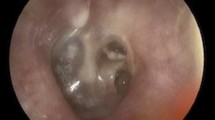Abstract
Retractions of the tympanic membrane constitute a large proportion of ear diseases causing concern to the otologist. The clinical features in a case of retraction pocket are varied and cholesteatoma. Also, that a retraction pocket in the posterosuperior region and pars ftaccida is a precursor of cholesteatoma is now well recognized. We have studied 60 cases of retraction pockets during a period of 5 years and have attempted to find out the etiology as well as the most effective treatment in such cases. Though over the years along with a dysfunctional eustachian tube, a sclerotic mastoid has been implicated as one of the causes of Retraction Pockets, we in our study have seen a large sized mastoid antrum (beyond 2 mm vf Lateral Semicircular Canal) as a consistent feature in most of our cases. This was subjectively assessed as a surgical finding in tympanomastoidectomy and objectively assessed by a high Resolution Computed Tomography of the temporal bone. We have found that a canal wall down mastoidectomy was the most effective in preventing the recurrence of retraction pockets. In a coutry like India, canal wall down mastoidectomy offers an acceptable solution to the problem of retraction pocket as not only is the follow up of patients poor but also the “Second- Look” procedure is not always possible. The use of 1- 0 chromic catgut in the middle ear instead of the more conventionally used silastic in preventing recurrent retractions can be considered as an effective single-staged procedure.
Similar content being viewed by others
References
Aoki, K, Saki, S, Honda, Y, Tos, M (1990) Effect of pneumatization of the mastoid An experimental study on pigs Acta Otolaryngol 110 399–409
Austin, D F,(1969) Types and indications of staging Archives of Otolaryngology 89, 235 242
Bennet, R G (1970) Significance and management of drumhead retraction pocket J Laryngol Otol 84, 167–187
Blaney, S P Tierney, P, Bowdler, D A (1999, Oct) The surgical management of the pars tensa retraction pocket in the child - Results following simple excision and ventilation tube insertion Int J Pediatr Otorhinolaryngol 25,50 (2) 133–7
Grewal, D S, Hathiram, B T (1997) Retraction Pockets in the Tympanic Membrane Aetiology and Management - Our viewpoint I J O and H N S Vol 49, No 2 125–129
House H P Polymers in Middle Ear surgery Arch Otolaryngol 1960 71 926–931
Jansen, C (1986) Retraction Pocket as a potential for cholesteatoma recurrence Laryngol Rhinol Otol (Stuttg) 65 (9), 499–510
Kobayashi,T Toshima, H Yaginuma, Y, Ishidoya, M, Suetake, M, Takasaka, T, Pathogenesis of attic retraction pocket and cholesteatoma as studied by computed Tomography Am J Otol 1994 15(5), 658–62
Mills, R P (1991) Management of retraction pockets of the pars tensa J Laryngol Otol 105(7) 525–528
Rambo J H T (1961) Use of paraffin to create middle ear space in musculoplasty Laryngoscope 1961 71 612–619
Sade, J The Atelectatic ear In secretory otitis media and its sequelae Churchill-Livingstone Publ Co New York-London 1979
Sheehy, J L (1972) Plastic sheathing in tympanoplasty Laryngoscope 83 1144–1158
Srinivasan, V, Banhegyi G, O Sullivan, G, Sherman, I W (2000) Pais tensa retraction pockets in children Treatment by excision and ventilation tube insertion Clin Otolaryngol, 25 (4) 253–6
Tos, M Incidence, etiology and pathogenesis of cholesteatoma in children in Paediatric Otology Edited by C Cremers and G Hoogland Basel Kaiger pp 110–117
Walsh, R M, Pracy, J P, Harding, L, Bowdler, D A (1995) Management of retraction pockets of the pars tensa in children by excision and ventilation tube insertion J Laryngol Otol 109(9) 817–20
Wehrs, R E (1979) Silicone sheeting in tympanoplasty Laryngoscope 89 497
Wittmaack, K (1918) Normale und pathologische pneumatization des Schlaefenbeins Jena, Gustav Fischer Verlag OCNA 1989 vol 22 (5) 847–56
Author information
Authors and Affiliations
Rights and permissions
About this article
Cite this article
Grewal, D.S., Hathiram, B.T., Moliorikar, A.V. et al. Retraction pockets in chronic suppurative otitis media- our experience. Indian J Otolaryngol Head Neck Surg 55, 107–112 (2003). https://doi.org/10.1007/BF02974614
Issue Date:
DOI: https://doi.org/10.1007/BF02974614




